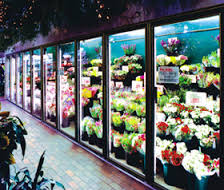I have to admit, I am a water junky. I drink most likely gallons of water a day. I have all but abandoned sodas, and only drink coffee in the morning. Otherwise, it’s all water. Of course, having such a water addiction means that I, like most junkies, want my “fix” all the time. And I want my “fix” to be the purest possible. For me, this means a reliance on filters at home, and bottles of water when I am not home.
I tell myself this is healthy. This is a good thing. That I am keeping my body healthy. And yet, I can’t help but wonder about the efficiencies of a system that makes clean and pure water available to drink, out of half-liter bottles.
There are a number of concerns here, almost all of which touch on environmental issues, but are also at their heart “supply chain” issues. For instance, if we are shipping cases of water, we are moving tons, literally tons, of water by truck. This uses resources that could perhaps be used, or even saved, to move other things. What resources? Well, the obvious resource is fuel required to power the trucks. In addition, the bottles of water take up space in trailers that could, perhaps, have been used for transporting some other good.
And then, of course, there are the issues of storage. Storage at the bottling plants, at the distribution centers, and finally storage at the retailer. A friend of mine used to work at a bottler, and she had told one of my classes that, to prepare for the busiest months of summer, they started stockpiling bottled water in January. This required that they seek “off site” contractor storage, just to store bottles of water! When you think about this, the costs just keep adding up. Obviously, the bottler incurs an additional cost when they have to pay a contractor for storage. But they also have to pay to transport the water to the 3PL (third part logistics provider’s) warehouse. Again, using fuel, and trucks. Finally, they have at least one additional step moving the water from that warehouse to the retailer, but more than likely bringing it back to their own distribution center first.
And of course, being a good conservative, seeking to conserve resources, I think we should also practice reuse, and recycling. This requires a collecting of the bottles, shipping them to a processing facility, and then sorting and melting them. Can you see the use of resources tied up now, heading both directions in this supply chain? All for the delivery of bottles of water?
A recent Wall Street Journal column by the Numbers Guy (Carl Bialik) tackles deals with the purity of the shipping container used for bottled water–the bottle!
Bialik point s out that “Nestlé claims it offers the lightest half-liter bottles in the U.S. market.”As he usually does, he tackles the statistics, and the numbers, behind the assertions. His quest? To determine if their claims are accurate. I decided to look at a slightly different angle. By reducing the weight of the bottle, what impact does that have on the logistics tail–the supply chain?
Bialik was provided the numbers by Nestlé, and since he trusted their data (gathered by Tragon) I will as well. Let’s assume that everyone uses normal, everyday water, and that any minerals added “for taste” are inconsequential to the issue at hand, the weight. We can be reasonably certain that a half-liter of water weighs a half-kilogram, or 500 grams. This then is our baseline. the lightest bottles (the new Nestlé bottles) weight 12.26 grams, and the heaviest ones weight 25.94 grams.
Simple math shows that reductions from the heaviest bottles (Fiji) to the lightest, will reduce transportation weights by 2.6%. Of course, not every bottle shipped is a Fiji bottle, and Nestlé has not replaced every bottle sold. The actual reduction in weight transported would be less, and thus the environmental and supply chain impact reduction would be less, as well.
What to do? Obviously the first solution is to drink more tap water. If at home, get a water filter. I have a Pur faucet filter, but any would work. Just go check out the selection at your local Wal*Mart or Target.
Might I also suggest we take a page out of the athletes’ book and start using reusable water bottles. Nalgene is the bottle of choice among the swimmers I know, but they are certainly not the only manufacturer. Just be sure to get a high quality water bottle to protect against the leaching of chemicals from the plastics and into the water, and thereby into you.
There are other positive stories coming out, including restaurants finally providing tap-water again, rather than insisting on selling you bottled water. I will work to update these stories on occasion as well. In the meantime, share with me your ways of reducing the logistics footprint, and thus both the environmental impacts, and the costs of logistics!




Here’s a few stats to ponder about bottled water:
* Bottled water uses energy and resources to create packaging for something that runs cheaply and cleanly from the faucet in your own home
* Not only is it expensive and energy demanding to make bottles, but then to ship the bottled water costs more money and isn’t eco-friendly
* 96% of bottled water is sold in single-size polyethylene terephthalate plastic bottles, which end up in city trash cans rather than recycling bins. The national recycling rate for all PET bottles, including soda bottles, is 23.1 percent
* About 4 billion PET bottles end up in the waste stream, costing cities around 70 million dollars a year in cleanup and landfill costs
* Bottled water costs around as much as a bottle of soda or juice, which obviously requires additional ingredients and processing, yet people pay for it
* Americans buy 28 billion water bottles a year, all that plastic and the energy used for manufacturing and transportation is very hard on the environment
* In addition to this, few bottles are recycled properly or reused but instead placed into the nearest trashcan
* Bottled water costs as much as $10 per gallon compared to less than a penny per gallon for tap waters
* Making bottles to meet Americans’ demand for bottled water required the equivalent of more than 17 million barrels of oil in 2006, enough fuel for more than 1 million United States cars for a year, and generated more than 2.5 million tons of carbon dioxide
* Some cities are considering taxes on bottled water, others are talking about bans on bottled water at city events, and even some restaurants have stopped selling bottled water in efforts to reduce waste
* If you choose to get your recommended eight glasses a day from bottled water, you could spend up to $1,400 dollars annually! The same amount of tap water would cost around 49 cents
* Bottled water often contains more bacteria and impurities than tap water, because the EPA regulates municipal water systems more stringently than the FDA regulates bottled water
* Worldwide, 2.7 million tons of plastic are used each year to make water bottles, and in the United States, less than 20% of these bottles are recycled
* Many things in this world get wasted, fill up our landfills, harming the environment and our health- don’t let bottled water, something so unnecessary and avoidable, be one of them
http://www.tappening.com has up to date statistics, facts, and figures that leads to a seriously simple solution: Stop drinking bottled water. Your tap water with a filter is just as good and basically the same exact water!
I whole heartily agree on the negatives of drinking bottled water, but what if you live somewhere where your water comes out of a well in an area that such as New England with its acid rain, where you don’t trust your ground water. Some areas, the envirnoment has been so polluted over the years, you just don’t know what you are getting when you open that tap.
I used to live in southern NY and had some of the best municipal water and my grandparent’s lived upstate where their water came out of Lake George (the northern end) which is tested several times daily and has the purest water in the state. Those taps I drank out of constantly, without fear.
I don’t trust my water here, even though I have had it tested several times. I do use it, but the majority of the water I drink if from a large bottle (think office cooler) in which I refill bottles constantly and when I am done, I do recycle them. I don’t see what choice I have other than installing a full water purification system.
Good points though. I have had these same concerns for years now.